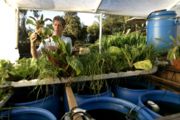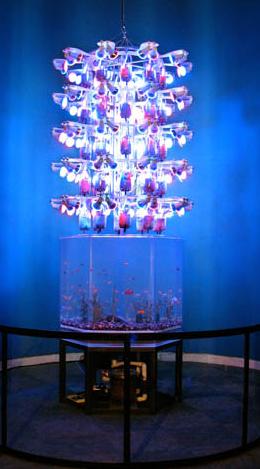Difference between revisions of "Food/Aquaponics"
| Line 1: | Line 1: | ||
[[Image:Aquaponics.jpg|right|180px]] | [[Image:Aquaponics.jpg|right|180px]] | ||
| − | |||
| − | + | Hydroponics is growing plants in water. Aquaculture is growing fish in tanks. The disadvantage of hydroponics is the constant input of mineral nutrients it needs. The disadvantage of aquaculture is the difficulty of keeping the water clean. Aquaponics combine the two systems and thereby cancels out the weaknesses of both. | |
| − | + | In aquaponics, edible fish are grown in a tank. The fish eat the algae that will grows naturally in nearly any still body of water. The fish effluent enriches the water with nutrients. This water then serves as the medium to grow hydroponic herbs and vegetables. The roots of the herbs and vegetables filter the water, which make it cleaner for the fish. Both the fish and the plants (and sometimes the algae) can be eaten by humans. | |
| + | |||
| + | Many aquaponics systems also include a wormery, which uses the inedible parts of the plants to feed worms. The worms are then fed to the fish and the compost they produces can be used to nourish more plants. | ||
| + | |||
| + | It should be apparent from this description that aquaponics is an extremely resource-efficient method of food production. It requires 10% the [[Fundamental resources/Water|water]] of growing vegetables in soil, because the water is constantly recycled rather than draining away. | ||
| + | |||
| + | [http://www.thegreencenter.net/ The New Alchemy Institute] found that a fish tank five feet in diameter and five feet tall can produce forty pounds of fish a year. (Meaning that you could have fish for dinner twice a week.) They perfected the method for growing tilapia, catfish or shrimp and even developed computer algorithms which could accurately predict the yield of fish based on variables [http://www.thegreencenter.net/pdf/solaraqua.pdf]. | ||
| + | |||
| + | {|style="border-spacing:8px;margin:-8px -8px" | ||
| + | |class="MainPageBG" style="width:100%;border:1px solid #ddcef2;background-color:#faf5ff;vertical-align:top;color:#000"| | ||
| + | {|cellpadding="2" cellspacing="5" style="vertical-align:top;background-color:#faf5ff;color:#000" | ||
| + | ! <h2 style="margin:0;background-color:#ddcef2;font-size:120%;font-weight:bold;border:1px solid #afa3bf;text-align:center;color:#000;padding:0.2em 0.4em;">Today's featured picture</h2> | ||
| + | |- | ||
| + | |style="color:#000"|<div style="text-align: center;"><p>[[Image:Farmfountain.jpg]]</p><p> [http://farmfountain.com/ Farm Fountain] is 'a sculptural ecosystem you can eat'. It shows how aquaponics can be applied as a vertical farming method. The design, by Ken Rinaldo and Amy Youngs, is available under a Creative Commons license and their website gives instructions on [http://farmfountain.com/howto/index.html how to build your own]. The fish tank at the bottom produces edible fish and effluent-enriched water, which is circulated among the bottles above, where plants are grown hydroponically.</p></div> | ||
| + | |- | ||
| + | |} | ||
Revision as of 10:56, 30 October 2010
Hydroponics is growing plants in water. Aquaculture is growing fish in tanks. The disadvantage of hydroponics is the constant input of mineral nutrients it needs. The disadvantage of aquaculture is the difficulty of keeping the water clean. Aquaponics combine the two systems and thereby cancels out the weaknesses of both.
In aquaponics, edible fish are grown in a tank. The fish eat the algae that will grows naturally in nearly any still body of water. The fish effluent enriches the water with nutrients. This water then serves as the medium to grow hydroponic herbs and vegetables. The roots of the herbs and vegetables filter the water, which make it cleaner for the fish. Both the fish and the plants (and sometimes the algae) can be eaten by humans.
Many aquaponics systems also include a wormery, which uses the inedible parts of the plants to feed worms. The worms are then fed to the fish and the compost they produces can be used to nourish more plants.
It should be apparent from this description that aquaponics is an extremely resource-efficient method of food production. It requires 10% the water of growing vegetables in soil, because the water is constantly recycled rather than draining away.
The New Alchemy Institute found that a fish tank five feet in diameter and five feet tall can produce forty pounds of fish a year. (Meaning that you could have fish for dinner twice a week.) They perfected the method for growing tilapia, catfish or shrimp and even developed computer algorithms which could accurately predict the yield of fish based on variables [1].
|

